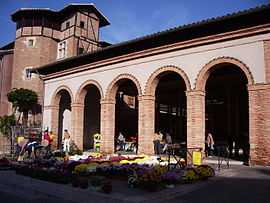Gaillac
| Gaillac | ||
|---|---|---|
 | ||
| ||
 Gaillac | ||
|
Location within Midi-Pyrénées region  Gaillac | ||
| Coordinates: 43°54′05″N 1°53′57″E / 43.9014°N 1.8992°ECoordinates: 43°54′05″N 1°53′57″E / 43.9014°N 1.8992°E | ||
| Country | France | |
| Region | Midi-Pyrénées | |
| Department | Tarn | |
| Arrondissement | Albi | |
| Canton | Gaillac | |
| Intercommunality | Tarn et Dadou | |
| Government | ||
| • Mayor | Michèle Rieux | |
| Area | ||
| • Land1 | 50.93 km2 (19.66 sq mi) | |
| Population (2006) | ||
| • Population2 | 12,775 | |
| • Population2 Density | 250/km2 (650/sq mi) | |
| INSEE/Postal code | 81099 / 81600 | |
| Elevation |
105–288 m (344–945 ft) (avg. 140 m or 460 ft) | |
|
1 French Land Register data, which excludes lakes, ponds, glaciers > 1 km² (0.386 sq mi or 247 acres) and river estuaries. 2 Population without double counting: residents of multiple communes (e.g., students and military personnel) only counted once. | ||
Gaillac (French pronunciation: [ɡajak]; Occitan: Galhac) is a commune in the Tarn department in southern France.
Geography of Gaillac
Gaillac is a town situated between Toulouse, Albi and Montauban. It has gained a large amount of recognition due to the wines that bear the towns name. The Tarn river runs along the border of the town by the south, east and west. It lies 50 km north-east of Toulouse. It is a market town and is the commercial centre of the north-west of Tarn.
History of Gaillac
The town was founded in the Second Century AD by the Gauls who created a river port where they exported their wine into Gallia Narbonensis. When Aquitane was conquered by Rome, Gaillac gained prosperity with its wine. However, the barbarian invasions annihilated the town and left nothing behind. It was only when the monks of Saint-Michel gained viticulture privileges from the Bishop of Albi, in 972, that the population stabilized and Gaillac started to become a town again. Their wines were at first sent to Bordeaux where they would be exported to England. The Abbey of St. Michel was constructed in the 10th century and rebuilt in 1271. In 1524 the abbey was secularized but the title of abbey retained.
During the religious wars, the "Gaillacois" refused to change their religion and remained Catholics and were chased out of the town by Protestants. They took refuge at Castelnau-de-Montmiral. After the St. Bartholomew's Day massacre on 24 August, 1572, in Paris, the Gaillacois massacred 74 out of the 90 Huguenots in the town. The abbey was once again rebuilt between 1572-1620. In the seventeenth century the Chateau of Foucaud was erected.
It was from the town of Gaillac that Louis-Philippe I addressed the words:
Nous chercherons à nous tenir dans un juste milieu, également éloigné des excès du pouvoir populaire et des abus du pouvoir royal.
Which may be translated: "We seek to keep ourselves in proper state, aloof from both the excesses of popular power and the abuses of royal power." This sentence would define the July Monarchy.
Administration
The mayors of the town have been:
- Henry Yrissou 1956-1977
- André Saux 1977-1983
- Jacques Dary 1983-1995
- Charles Pistre 1995-2005
- Michèle Rieux 2005–present
Transport
Sport
- UA Gaillac - Local rugby team.
Twin towns
See also
References
| Wikimedia Commons has media related to Gaillac. |
.svg.png)